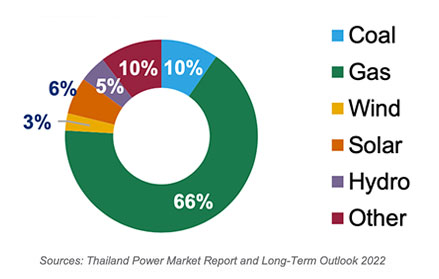Markets Thailand
Thailand one of largest power market in Southeast Asia with 216 TWh of power consumption in 2021. It’s expected to grow at a rate that averages 2.3% per year to 403 TWh in 2050. Power demand grew by 5.1% in 2021 as the economy recovered from coronavirus, and 3.2% annual growth is expected between 2022 to 2026. Demand growth will be driven by new industrial demand from sectors such as automotives, smart electronics and robotics. Battery storage will increase to 18 GW in 2050 from nearly zero today to support the growth of variable renewable energy.
Installed Power Capacity (2021)

- 85% of power was sourced from fossil fuels in 2021 and the renewables share was 15 % and will increase to 22% by 2030
- The share of coal will drop from 21% in 2021 to 16 % in 2030, while gas remains relatively stable, slightly decreasing from 64 % to 62 % over the same period
- Solar’s share of generation will rise from 2% in 2021 to 5 % in 2030 while wind will increase from 2% to 3% over the same
- Solar capacity will increase from 3.4 GW in 2021 to 10.2 GW in 2030, and then 76 GW by 2050
Average Electricity Prices (Industrial User)

- Average Electricity Prices (Industrial User) rose by 6.3% per year on average from 2011 – 2022 a year on average
- End user tariffs increased 37 % from US$113/MWh in 2021 to US$155/MWh in 2022 , as generation costs are passed through (as coal prices and gas prices increased)
- Tariffs are expected to be high in the early 2020s as fuel prices especially gas remain at elevated levels before falling back by 2025
- Transmission & distribution costs will increase and keep tariffs relatively high as more variable renewable energy enters the system
Regulation
Government Lead Initiatives:
- Alternative Energy Development Plan (AEDP, 2018-2037) Increase the proportion of renewable energy and alternative energy in the form of electricity, heat and biofuels by 30 percent in 2037
- AEDP Target for 2037: the percentage of electricity consumption from alternative energy will be 32.9%, mainly driven by solar energy
- From the total 18,696 MW of planned renewable energy, solar is expected to deliver 9,290 MW, including floating solar of 2,725 MW
- At COP 26, Thailand committed to reach carbon neutrality by 2050 and net zero GHG emissions by 2065
- Thailand also pledged to reduce GHG emissions by 30-40% in 2030 from the previous target of 20-25%
Implementation:
- Setting the pricing for renewable energy is now used to determine the feed-in tariff (FiT)
- PV competitive with retail power prices > some leading companies target the self-consumption segment
- The government intends to increase the network’s capacity to distribute electricity in order to accommodate rising generation capacity, particularly from renewable sources
- The Thailand Government set up a target for the installation of 90 MW/year from 2023 to 2025, with a possibility of upward adjustment in its Powe Development Plant 2020
- Net-metering pilot scheme for 100 MW
